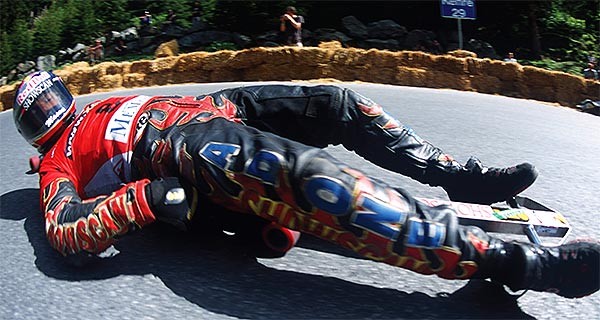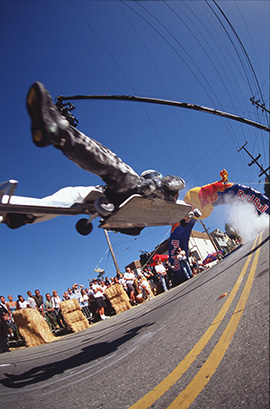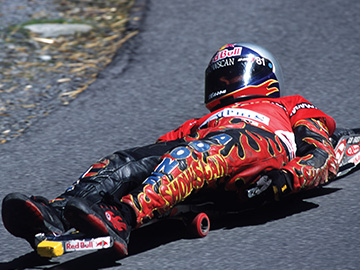
You are zipping down a steep hill, suspended two inches from the ground. The only thing separating you from the concrete is an aluminum board. Your feet rests on pegs, your back is flat on the board and your head is slightly elevated so you are able to see where you are going. You are reaching speeds of up to 100 km/h. The only equipment protecting you is a motorcycle helmet and a leather body suit. Welcome to the extreme world of street luging.
 The concept is actually quite simple: up to six racers go head to head bumping and passing each other and the first one to cross the finish line claims victory. A street luge is operated by someone appropriately called the “pilot.” Tom Mason, a professional street luger and stuntman, affectionately known as the “Bad Boy of Street Luge,” summed it up best when he said, “For a few seconds, I am truly flying like Superman and feel like a speeding bullet.”
The concept is actually quite simple: up to six racers go head to head bumping and passing each other and the first one to cross the finish line claims victory. A street luge is operated by someone appropriately called the “pilot.” Tom Mason, a professional street luger and stuntman, affectionately known as the “Bad Boy of Street Luge,” summed it up best when he said, “For a few seconds, I am truly flying like Superman and feel like a speeding bullet.”
It is unknown exactly how street luge originated; however, luging as a professional sport began in the 70’s. It evolved from skateboarding and has obviously been taken to a more extreme level. The first organized event is said to have taken place in 1978. Unfortunately, it ended in disaster when athletes and spectators were injured. It was not until 1995 that street luge was presented to a national audience at the X Games.
Since then, street luging has exploded as it gained popularity with adrenaline junkies, and is now at an all-time high with over 1000 participants scattered across the globe. There are officially-sanctioned annual events in Europe, Australia, and throughout the United States that lead up to the ultimate crowning event: the X Games where as much as $400,000 USD has been up for grabs. With companies like McDonald’s, Mountain Dew, MTV, Fox Sports and ESPN supporting the sport and the lugers, street luging is expected to continue to attract a huge fan base and athlete interest.
Roddy Stevens, a 16-year-old street luger from Toronto, said “I initially became interested in luging when I saw a documentary about it on television.” Stevens say that, “almost anyone can learn to street luge with a couple of months of tutoring,” but emphasized that, “it takes years of practice to become proficient at racing other lugers. It takes time to develop your own styles and techniques.” He suggests anyone interested in street luging should surf the internet and read as much information as possible to become informed, and talk with other people familiar with the sport.
Street luges range in price from $1000 to $2000, but can be less expensive if you make your own. The guidelines to build a street luge can be found on the internet and will probably cost between $500 to $1000 dollars to complete. Other than your board, your basic essentials are safety gear. Safety is a very important aspect of the sport and street lugers agree that not taking the proper precautions is foolishly risking your life. Good safety equipment, which includes full body leathers, gloves and a helmet will cost you about $1000.
So, if you’ve got some cash and a need for speed, then street luging might just be for you.
(Editor’s Note: A good book on the sport is Darren Lott’s Streetluge Survival Guide.)

Talk the Talk
Amped: When you’ve got the adrenaline rush going!
Bacon: Very rough, hazardous road surface conditions.
Banana: A rider who wipes out often.
Chucking bales: Crashing into hay bales (used as barriers on tracks) with enough force to move them.
Drop a hill: Ride a luge course.
Flame: Urethane luge wheels catching fire as a result of high speeds.
Flowing like water: A fluid and even run down a luge course. The ultimate ride.
Road rash: Body burns from scraping the road surface.
Scrambled eggs: Bad road surface. Not as bad as “bacon”.
Wail, wailing: Going “wicked” fast…

Comments are closed.